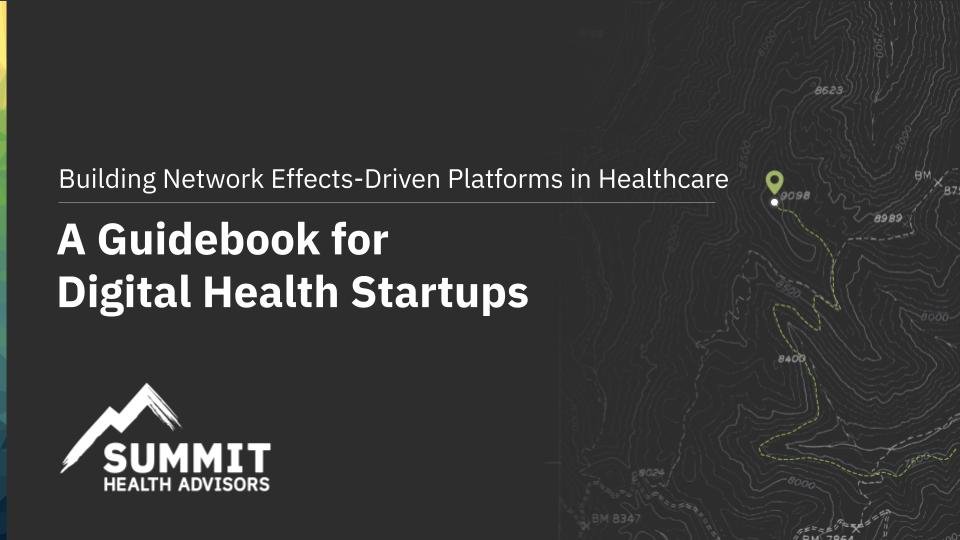A Conversation with GoodRx’s Doug Hirsch: Empowering Healthcare Consumers through Platform Business Strategy
This long-form interview is the first in a series of conversations with leading digital health platform CEOs and investors. An abridged version of each interview was originally featured in Summit Health Advisors’ 2024 State of Healthcare Platforms Report.
Doug Hirsch, co-founder and Chief Mission Officer at GoodRx, spoke with Seth Joseph, Managing Director at Summit Health Advisors, about what it took to scale one of the leading platform companies in healthcare.
In this conversation, Doug speaks about some of the challenges and successes GoodRx faced in growing their platform business, including:
How GoodRx cold-started their platform and attracted their first users.
How GoodRx outcompeted well-funded rivals by reducing barriers to adoption.
How GoodRx created harmony between several different, unaligned constituents on the platform.
How GoodRx is expanding into new markets and how Doug sees the future of healthcare.
A Conversation with Doug Hirsch
Seth Joseph: How did you overcome the cold start problem and attract your first users to the network? And once you got the flywheel going, how did it attract other users to the platform?
Doug Hirsch: I’ll honestly call it naivete or stupidity or one of those. We just didn't know any better. My background is technology. I worked at Facebook, and Yahoo before that. We didn't understand PBM dynamics. We didn't understand, frankly, how drugs were priced. And nobody could actually answer it, including the people involved in the food chain.
So, V1 of GoodRx, which we launched at Health 2.0, was really just scrapped websites. Costco publishes prices on their website. Walmart has their $4 and $10 list. Some of the online pharmacies had prices. And so we just kind of cobbled stuff together. We tried soliciting people to take pictures of their receipts, which was a mess, asking people to self-report. So we really kind of faked it in V1, when we didn't have access to contracts. We just had retail prices, which of course, are not necessarily a great indicator for what people actually pay.
Because we were sort of tech geeks, we wanted to take the next step and understand the underlying pricing dynamics that actually delivered savings to the consumer. And so with a little bit of hard work and some smarts, we basically managed to, in participation with the PBMs, say here's what this drug is actually going to cost at this pharmacy based on this contract. And then we got multiple contracts, which nobody else had really done to date. I think our biggest novelty was to show the consumer exactly what the prescription price would be at the pharmacy, and then by layering on multiple networks, the consumer could get the best price.
It was so exciting to just decipher this data, which had been locked up for so long, and put it into a format that a consumer could understand.
And then we just assumed desperate consumers would go after it. But really the marketplace that we ended up serving, which we didn't realize when we first launched, was physicians who desperately wanted access to information.
And so that was kind of the initial, cold start phenomenon for us, and how we got our first users onto the platform.
Seth Joseph: There were other very well-funded companies who haven't done as well as GoodRx. What are the things you feel you got right that have been critical to your success?
Doug Hirsch: It sounds sort of trite to say it, but we were always just focused on the patient, the consumer, which nobody really does in healthcare. You forget that at the end you've just got a scared, frightened patient who's trying to stay healthy. So I think a lot of it comes down to the experience of the consumer.
A patient comes to this thing called GoodRx, because their doctor or a friend told them about it. We don’t ask them for anything to get started. They didn't have to sign up or give us their information. They could literally print out a coupon, just like you would for a TV.
This was different from competitors who were asking for tons of drug information: names, dosages, forms, quantities. And asking for credit card information. This made it relatively complicated and I think people had a hard time using other solutions.
To this day, I think our competition is honestly people, and their habits. Activating passive healthcare consumers is an incredibly difficult thing to do.
Seth Joseph: You have a platform business with multiple constituents: pharmacies, PBMs, doctors and consumers. As they all have different interests, how do you align incentives and interests or determine whose interests are most important.
Doug Hirsch: We try to be Switzerland. We need to be neutral. The pharmacy side and the PBM side of the network are typically the toughest relationship, in terms of competing priorities and needs.
As a platform, we need to figure out what each group cares about most. This requires constant listening and adapting based on what we’re hearing. It's a never ending series of discussions and listening and innovating, so that you can make sure you keep all parties happy.
Ultimately, we need peace; this helps the consumer and creates the greatest benefits for all parties on the network. We are trying to represent the consumer who's just trying to get a drug. That’s our highest priority.
Building a platform business in healthcare?
Check out Summit Health Advisors’ Guidebook for Digital Health Startups for proven network effects strategies and best practices.
Seth Joseph: Platform business models are obviously quite distinct from typical SaaS models. Can you talk about your business model and how it helps drive value?
Doug Hirsch: In terms of the evolution of the revenue model, it's always been relatively straightforward: if we can help consumers fill their prescriptions, we can get rewarded.
Early on, we stumbled onto this concept that you can actually get paid when someone fills a prescription. Sort of like a referral fee. And, obviously that can be quite lucrative and it's a recurring thing because most people with chronic conditions are taking their drugs every month.
The roots of the company remain around having a deep relationship with a consumer and enabling them to access the medication they need.
Seth Joseph: In many multi-sided networks, there's this idea of a tipping point. This idea that when you hit this magical tipping point, everything's going to become a self sustaining, virtuous cycle. But in reality, it’s a little bit messier than that. Would you say GoodRx has reached the tipping point? And how do you think about this from a metrics standpoint?
Doug Hirsch: I can give you a bunch of stats that make it sound like we’ve reached the tipping point. We've saved Americans $65 billion, we've prevented over $5 billion in hospitalizations, we’ve filled $184 million prescriptions that consumers would not have been able to afford otherwise. We have incredible numbers across the board.
On the other hand, I could never say we're at a tipping point because to me, as an entrepreneur, it's a never ending battle. The tipping point is over when everybody can get the prescriptions they need at a price they can afford.
The times I get the most satisfaction is when I see our product actually in the world. I was in line at a Walgreens recently, and a woman in front of me was telling her other friend about GoodRx. That feels like a personal tipping point where I'm so proud of this thing. I'm going to continue to fight for every prescription because I just want consumers to be more educated, more active in their care.
Ultimately, GoodRx probably won’t fill every single prescription that consumers have, but we want to be there when people need help.
Seth Joseph: How do you think about growth, in terms of expanding the platform, adding constituents to the network or acquisitions like HeyDoctor? And how do you ensure that as you expand, it makes sense and benefits all sides of the network?
Doug Hirsch: For me, everything falls into the categories of affordability and convenience.
If you made every drug on the planet free, people would still stop taking them and wouldn’t adhere for a whole host of reasons. And so one of the things we want to do is make it easier for people to stay on therapy.
So the thought process for HeyDoctor, which was not a huge acquisition in the scheme of our business, was really around one of the friction points: people can't get a refill on their prescription. They need a prescription for something pretty straightforward, like a UTI, where it's not risky. And they can’t get it.
We were very cognizant of the fact that we're not trying to cannibalize physical doctor visits, but there are opportunities where you can't see the doctor. And actually doctors love what we did because it's not fun for their office to check a box on refilling a simple prescription.
I spend an inordinate amount of time thinking about all the innovation in fast food or in any retail establishment, like self service checkouts, to see how we can help a patient fill their prescription. And also drive additional profits for the retailer or the manufacturer, by supporting patient adherence. Everyone benefits.
Seth Joseph: What do you see as the next big thing for GoodRx or even for consumers in healthcare more broadly.
Doug Hirsch: I think there's a lot of opportunities just continuing to focus on access and affordability. It sounds so boring, but why can't I just tell my insurance company, this is the pharmacy I go to and this is the price I want to pay for this drug. And they either say yes or no. It's such a simple idea.
I think the future of healthcare is going to be around simplifying things for the consumer. Giving the consumers more control over their health.
And hopefully this translates to better health outcomes. But I'm not sure we're there yet. When I think about what’s next, it falls into the categories of convenience, access and affordability, and then hopefully innovation comes from there.
—
If you’re building or scaling a platform business in healthcare and want advice from experts who have been there before, please reach out. We have first-hand experience growing some of the largest, unicorn digital health platform businesses, and we’d love to help.


